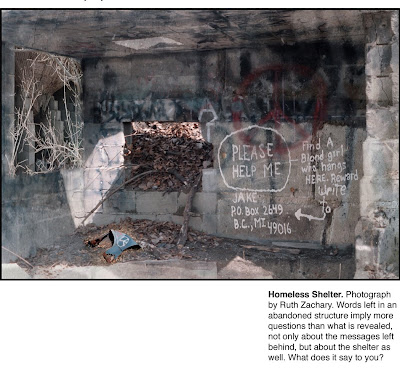 WHAT IS STYLE?
WHAT IS STYLE?Once I enrolled in a beginning photography art center class, taught by Gary Ciadella.
He sent us out to snap pictures of things, scenes, people, etc. which attracted us. When we returned with our newly developed black and whites, he projected our images on a screen.
I would never have dreamed beginners would display a group of pictures with distinctive characteristics different from every other person in the class, but that was what emerged! Every person displayed certain tendencies for certain types of composition, for either very dark or very high key scenes, and of course a preference for particular subject categories. Some compositions seemed to slide off the bottom of the format. Some were contained within tight boundaries. There were many more of these traits we all could identify and the differences between us were apparent .
I would define style as the unique combination of preferences, choices, or biases the artist employs during the creative process. This may include media, color choices, compositional preferences. Working within certain limitations may create a certain commonality in the work, interpreted as style. Subject matter, format shapes, intimate views, far away vistas, and more come into play. Much of this process is like hand-writing and is just as unique.
After that time, I never tried to “develop a unique style.” I was assured my style was already there, and that making every piece of art the best I could was a more important goal.
I am convinced that working diligently will ensure every artist will develop his or her own unique style. My advice to the beginner is to learn what you can from others, but to trust the result will still be your own original expression.
Work done in various media each may have the look of a different style. My own choice is to mix media and to choose the materials and tools which express in the best way I know the particular effect I am going for. It may appear sometimes as if I have no particular style, but that is a conscious choice. I can see direct relationships between one series and the next, and how what I have just learned is translated into the next body of work. I can articulate what those discoveries were.
MESSAGE
Later in the class mentioned above, Gary Ciadella showed us a series of photographs by world-renouned photographers. He asked us what the artists were saying with their pictures. We began to comprehend many possible meanings in these images.
Every piece of artwork says something, even if it is only about an abstract arrangement of shapes and colors. Awareness of meanings conveyed through images is inescapable for me since that time. Symbolism through imagery is absorbed even when the viewer is not aware. Advertisers are aware of this and use it all the time. If you are aware, you can resist their efforts to make you buy.
Sometimes an artist is aware of the message or idea they are trying to express. Sometimes a piece will say something else to the viewer. When more than one person sees something in your work you did not see before, and several interpret this idea the same way, it offers an opportunity to learn about what you are subconsciously saying with your work.
These two classes in photography affected all the artwork I created from that time on. To see the work of my former teacher, Gary Ciadella, click the links below.
www.carrciadella.com www.exclusivelyblackandwhite.com







